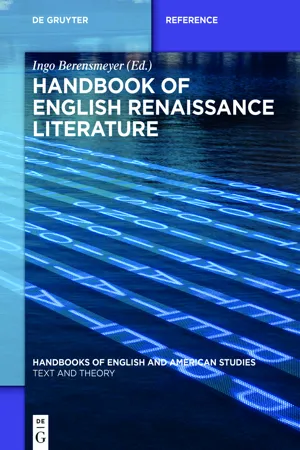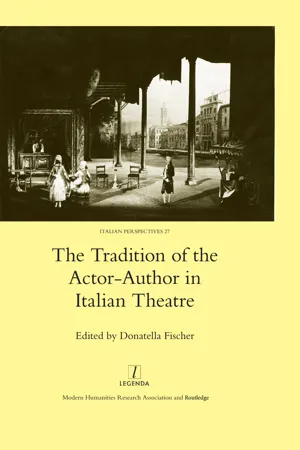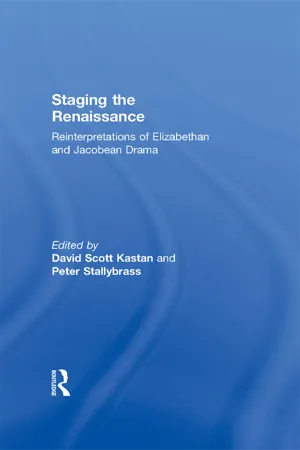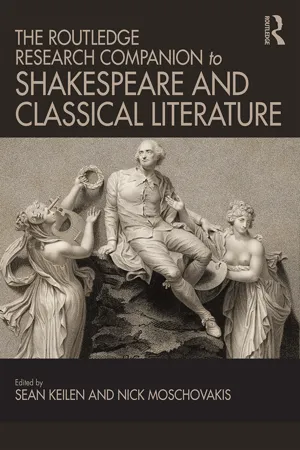English Renaissance Theatre
English Renaissance Theatre refers to the theatrical productions and performances that took place in England during the Renaissance period, roughly from the late 15th to the early 17th century. It was a time of significant growth and innovation in English drama, with the works of playwrights like William Shakespeare and Christopher Marlowe becoming iconic examples of the era's theatrical achievements. Theatrical forms such as tragedy, comedy, and history plays were popular during this time.
7 Key excerpts on "English Renaissance Theatre"
- eBook - ePub
English Literature
A Student Guide
- Martin Stephen(Author)
- 2013(Publication Date)
- Routledge(Publisher)
...This produced a feeling of heady excitement, but, as a movement which also challenged all existing knowledge, it could also produce the black depression and loss of all certainty seen in some Elizabethan and particularly Jacobean work. The Renaissance is at best a very loose concept, deemed to have lasted until early in the seventeenth century. Perhaps the greatest symbol of the Renaissance is Shakespeare’s Hamlet, containing as he does within himself in almost equal measure the potential for perfection and the potential for self-destruction. RESTORATION: the period of Charles II’s restoration to the English throne produced both comedy and tragedy in the newly built theatres, but Restoration comedy is now far better known than Restoration tragedy. In the Restoration period the nature of the plays being performed changed radically from Shakespearian and Jacobean times. Restoration comedy deals almost exclusively with the affairs of the London upper classes. It is graceful and sometimes bawdy, heavily concerned with sexual behaviour and money, and places a huge premium on WIT as a major social virtue. It tends to contain several stock figures, such as the beau, the dandy or fop, the young rake, and the country or rustic bumpkin. Best-known authors are William Congreve (1670–1729), William Wycherley (1640–1716), Sir George Etherege (71634–91), George Farquhar (1678–1707), and Sir John Vanbrugh (16641726). Congreve’s The Way of the World (1700) is often viewed as the masterpiece of the GENRE. Wycherley’s The Country Wife (71675) is one of the most cynical and unpleasant of restoration comedies, whilst Vanbrugh’s The Relapse (1696) illustrates the free and easy ways of the time...
- eBook - ePub
The Routledge History of Literature in English
Britain and Ireland
- Ronald Carter, John McRae(Authors)
- 2016(Publication Date)
- Routledge(Publisher)
...There was a similar explosion from the start of the seventeenth century in the discovery, development and use of clocks, telescopes, thermometers, compasses, microscopes – all instruments designed to measure and investigate more closely the visible and invisible world. The writing of the era was the most extensive exploration of human freedom since the classical period. This led English literature to a new religious, social and moral identity which it maintained until the mid-nineteenth century. English became one of the richest and most varied of world literatures, and is still the object of interest and study in places and times distant from its origin. The Reformation and the century of cultural adjustment and conflict which followed are crucial keys in understanding English literature’s many identities. The literature of the English Renaissance contains some of the greatest names in all world literature: Shakespeare, Marlowe, Webster, and Jonson, among the dramatists; Sidney, Spenser, Donne, and Milton among the poets; Bacon, Nashe, Raleigh, Browne, and Hooker in prose; and, at the centre of them all, the Authorised Version of the Bible, published in 1611. So many great names and texts are involved because so many questions were under debate: what is man, what is life for, why is life so short, what is good and bad (and who is to judge), what is a king, what is love. . .? These are questions which have been the stuff of literature and of philosophy since the beginning of time, but they were never so actively and thoroughly made a part of everyday discussion as in the Elizabethan and Jacobean ages. Politically, it was an unsettled time. Although Elizabeth reigned for some forty-five years, there were constant threats, plots, and potential rebellions against her...
- eBook - ePub
- Ingo Berensmeyer, Ingo Berensmeyer(Authors)
- 2019(Publication Date)
- De Gruyter(Publisher)
...They add pathos and weight to such mundane, perhaps rather trivial concerns as undressing before going to bed, but at the same time they deflate imperial ambitions, adding a dose of irony that targets perhaps both Ralegh-style expeditions to the Amazon and a particular masculine/adolescent attitude to women (↗ 27 John Donne, Songs and Sonnets). Taking into account that the name of the best-known Elizabethan playhouse is “The Globe”, and that Shakespeare and other dramatists love to pun on the name’s implications, one realises that this union of the global and the local, the imperial and the provincial, the intimate and the political may be a key to understanding the thematic scope and the cognitive functions of English Renaissance literature. Poetry, drama, and prose offer new ways of reflecting and shaping a word that is expanding both externally, in the reach of global exploration, and internally, in the world-making activities of minds and texts (↗ 3 New Ways of Worldmaking). 2 Renaissance Literature and Literary Culture The flourishing of literature and the arts in the English Renaissance is closely connected to the diffusion of humanist ideals of education in the classics, in rhetoric, and in modern languages (see Carroll 1996). Influential new schools founded in the second half of the sixteenth century, such as the Merchant Taylors, Rugby and Harrow provide a secular education that can continue at Oxford or Cambridge, or at London’s newly founded Gresham College (1596). Studying law at the Inns of Court is another professional opportunity. The new ideal of the gentleman – in contrast to the priest or the knight – designated an accomplished person who had acquired useful skills in speech and writing, but also in mathematics, law, versifying, and dancing, a person who was well-trained to serve the state in an administrative capacity...
- Donatella Fischer(Author)
- 2017(Publication Date)
- Routledge(Publisher)
...Ecco allora che questa forma espressiva — forma vitale di un popolo — trova sfogo nelle manifestazioni spettacolari, nell’immaginazione di questi attori, nelle loro invenzioni di un linguaggio mimetico e parlato. 4 The actors replaced the authors as the central figures and prime creators in theatre production. Machiavelli and Ruzante are adduced not only for their own achievements but also as forerunners of a tradition of playwriting which, had it been allowed to flourish, might have compared in excellence and variety with that which emerged in Elizabethan England. Before dealing further with that question, it might be helpful to trace certain crucial developments in the early professional theatre of the two countries. The two proceeded independently but along largely parallel lines, although there can be no doubting the debt of English culture in general to Italian Humanism. It is no accident that many Elizabethan plays were set in Italy or were inspired by Italian tales, for England was in love with Italy and followed with keen interest the central developments of Renaissance style and thought. In some sectors, there was a certain delay before new trends embedded in Italian culture made their impact in England. For instance, the differing impact of the new cult of classical antiquity is apparent from a cursory examination of the dates of the first publication of Latin authors. The year 1470 saw the first publication of Terence in Italian, and c. 1480 the first edition of Seneca, but it was 1581 before Seneca His Tenne Tragedies was issued in English. The process by which the playwright emerged in his own right as a writer equal to the poet, historian, or philosopher can be compared to the emergence of the architect from the anonymous medieval mason...
- eBook - ePub
- David Scott Kastan, Peter Stallybrass, David Scott Kastan, Peter Stallybrass(Authors)
- 2013(Publication Date)
- Routledge(Publisher)
...Returning in some sense to the historical interests of an even earlier scholarly age, recent criticism of the drama increasingly has insisted upon it not primarily as a “poetic” and individual art, but as a theatrical and collaborative activity, demanding a focus both on its discursive complexities and on the institutional conditions in which it was produced, demanding, that is, theoretical and historical commitments unnecessary and impossible for Kaufmann and his contemporaries. Feminism, Marxism, poststructuralism, and psychoanalysis have productively transformed the ways in which we now conceive of texts and representation, while at the same time a renewed attention to historical specificity, necessitated precisely by the largely metaphoric if not metaphysical appeals to “History” of many of these theoretical initiatives, has emphasized the importance of the particular, and often contradictory, material determinants of the Renaissance stage. As criticism has moved away from the formalism of the 1950s and 1960s, it has had to recognize that dramatic texts are sites rather than the exclusive sources of meaning, places where audiences, readers, actors, writers (not to mention scribes and compositors) construct and contest meanings. And those meanings are in turn inflected by systems of patronage, censorship, and newly emergent market relations. In the English Renaissance theater, the text is structured by the multiple and complex collaborations that the theater demanded between patrons and players, playwrights and printers, playhouses and playgoers. The essays in this volume attempt to register these collaborations, emphasizing the ways in which the theater is at once responsive to and constitutive of the social formations of Renaissance England. At the same time, these essays recognize that their historical grounding is not unproblematic...
- eBook - ePub
Victorian Transformations
Genre, Nationalism and Desire in Nineteenth-Century Literature
- Bianca Tredennick, Bianca Tredennick(Authors)
- 2016(Publication Date)
- Routledge(Publisher)
...Literary categories are rearranged into an unanticipated new hierarchy not thought possible or even particularly desirable by the Victorians themselves. Redefining drama is part of this shake-up. Queen Victoria herself highlights fears about drama as a genre when she establishes the Windsor Theatricals, a series of plays performed between 1848–1860 for Britain’s royal family and their guests. These productions were “an attempt,” as Victoria herself wrote, “to revive and elevate the English drama which has greatly deteriorated through lack of support by Society” (qtd. in Rowell 47). The Theatre Regulation Act of 1843 had loosened restrictions on the kinds of plays certain theaters could produce; 2 however, the Lord Chamberlain’s office continued to wield censorship power over all plays licensed for performance in Britain. The official Examiner of Plays was particularly strict about topical religious and political content. Michael Booth notes that this “exclusion of politics and religion from the stage … contributed to the feeling among many contemporaries that the drama was trivial and isolated from the mainstream of English life” (146). In spite of continued government prohibitions, popular interest in drama intensified. By the end of the 1850s, play-going underwent a shift that demonstrates drama’s widening popular appeal; whereas shorter theatrical runs had been the norm to keep audiences coming back for new material, plays in the fifties began attracting larger audiences and more sustained audience interest so that, by the middle of the decade, the most popular plays ran for more than one hundred nights (Booth 13). Productions at mid-century also coincide with a heightened awareness of Englishness as display that serves to consolidate national identity. The 1850s begin with the high-profile success of the Great Exhibition, the central purpose of which is to put English culture on show...
- Sean Keilen, Nick Moschovakis, Sean Keilen, Nick Moschovakis(Authors)
- 2017(Publication Date)
- Routledge(Publisher)
...13 Classicism on the English Stage During Shakespeare’s Youth and Maturity Popularizing classical learning Jeanne H. McCarthy Though classicism had become a draw for popular audiences when Shakespeare began writing for the stage (likely) in the 1590s and its place in the theater was well established by the end of his career, this outcome was far from inevitable. Rather, as we shall see, classical influence on the public stage continued to be contested throughout Shakespeare’s career. Often, it was the learned who most strongly resisted such popularizing on the grounds that the professional theater could hardly be decorous or learned enough to handle such matter. Indeed, a number of university-educated critics believed that classicism in commercial playhouses was inevitably an offense against decorum, an incongruous mixing of high and low, learning and ignorance. Grammar school-educated authors thus struggled to avoid charges of pedantry or dilettantism while a number nonetheless promoted a more classically inflected drama. In this context, the project of redefining popular stagecraft by introducing classical influences—including classical genres, aesthetics, or even coherent plots in unified plays with something resembling a “regular” five-act structure—seems improbably ambitious. That such a transformation would be achieved can be attributed to a century-long experiment in English humanist engagement with classical texts, particularly in the grammar school. The prominence of children’s performance of classically informed drama in the culture, not only in London but throughout the countryside, thus had a significant influence upon the extension of a preference for literate ideals and classicism within Renaissance audiences...






